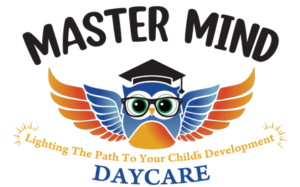Early childhood education is a necessity for kids. When young children have the opportunity to investigate the world around them, they learn and experiment with new STEAM skills and theories. Research has shown that there is a positive relationship between early STEAM experiences and future success in school.
- STEAM stands for Science, Technology, Engineering, Art, and Math.
STEAM learning begins early. But STEAM isn’t about showing an infant or toddler flashcards or teaching equations. It is the hands-on thing that children do every day. That is why, at Mastermind Daycare, we keep the hands-on experiences for the child as a number one priority.
STEAM learning covers various activities, like exploring shapes, crafting cardboard forts, pretending to run a “grocery store,” pouring and mixing different materials, and experimenting with paints to create new colors. These are just a few examples. Many of the things kids do every day involve STEAM skills, even if we don’t always realize it.
What Does Steam Stand For?
S is for science
Children are naturally born scientists. Moreover, they have curious mindsets and they try to figure out everything around them. They are always curious about how the world works by involving themselves in a scientific method. Therefore, you will often see a child playing with blocks and trying to shape them together.
Additionally, children notice patterns and come up with theories to explain what they observe. They gather “data” to test these theories. Think of a theory as a guess or a possible explanation. For example, a toddler makes footprints after walking through a puddle. She might develop a theory by looking at her footprints, like how her walking style affects the size and shape of the prints. To test her theory, she might hop on one foot or walk on her toes to see if her prints change. Furthermore, it’s all part of their learning process.
T is for Technology
Living in the 21st century, the first thing that comes to mind is cell phones, right? However, the “T” in technology stands for any type of man-made object. Moreover, you will often see kids playing with scissors, ramps, and wheels. They support children’s cognitive development because as children play with these tools, they learn a lot from them too.
E is for Engineering
Engineering involves using science, math, and technology to solve problems. Furthermore, it’s about using materials, designing, crafting, and building to figure out how and why things work.
A is for Arts
Every kid is an artist. Moreover, STEAM was originally STEAM. However, to make it STEAM, arts was added. Creativity is very important for every child. Therefore, children engage in painting, pretend play, music, and drawing. Art is sensory exploration. As a parent, you must make your child comfortable with playing around with paint. At Mastermind Daycare, we ensure that children can feel the paint on their fingers and see colors change the way the paper looks.
M is for Math
Toddlers start to grasp early math ideas such as geometry and spatial relationships when they get hands-on with new objects and use their mouths to explore. Additionally, teachers can help these little ones learn math by consistently using math-related concepts throughout the day.


